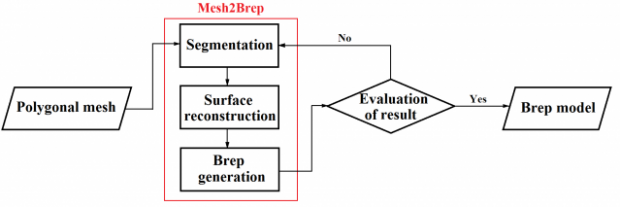Latest News
June 14, 2018
C3D Labs is developing a new product to transform polygonal models into boundary representation (b-rep) bodies. The new module, named C3D Mesh2Brep, will be added to the C3D Toolkit and is designed to work together with the C3D Modeler geometric kernel.
With C3D Mesh2Brep, CAD developers will be able to transform polygonal models into b-rep bodies. The resulting b-rep model then allows users to employ CAD tools to make changes (such as Boolean operations and chamfers), and to generate additional data, such as through projections and sections.
The company suggests various applications of C3D Mesh2Brep. One possible use is in the area of reverse engineering, which involves 3D scanning a part and then turning it into an editable CAD model. In CAE systems, developers could use the Mesh2Brep module to process the results of topological optimization. Computer graphics designers could use the new module for grid smoothing, decimation and applying compression algorithms.
How C3D Mesh2Brep Works
The transformation of a polygon mesh is a three-step process by C3D Mesh2Brep:- In the first step, C3D Mesh2Brep segments the mesh by dividing the set of polygons of the original mesh into subsets (segments), taking into account their relation to specific surfaces.
- Next, the segments are used for surface reconstruction.
- Lastly, the data obtained in the previous steps is used to construct the b-rep model.
“Our new C3D Mesh2Brep module has two main modes: fully automatic, and interactive,” says Andrey Tumanin, lead developer of the C3D Modeler geometric kernel. “Automatic mode generates acceptable results for high-quality polygon meshes, which are triangulations of CAD models that mostly contain elementary surfaces. If, however, a polygon mesh is constructed from 3D object scans and so contains general surfaces, then the user will have to be involved in the process.”
About the Beta Program
C3D Labs is now gathering feedback to create its first ready-to-use version of the module. A beta version will be available for testing in July, with the final release scheduled for September this year.To join the beta testing program, or for more info, visit C3D Labs.
Sources: Press materials received from the company.
Subscribe to our FREE magazine, FREE email newsletters or both!
Latest News
About the Author
DE’s editors contribute news and new product announcements to Digital Engineering.
Press releases may be sent to them via [email protected].







 Example of a workflow. Image courtesy of C3D Labs.
Example of a workflow. Image courtesy of C3D Labs.